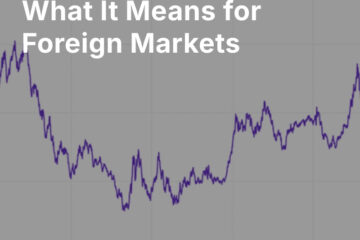Why Emerging Markets Could More Than Double Before the Bull Is Over
Back in April, we drew attention to the ongoing rally in emerging markets that began early in 2016, corrected sharply at the time of the U.S. election last November, and then took off again as fears of a global trade war receded.
Our observation in April was primarily about the relative valuations of the U.S. and emerging markets. Although the gap has narrowed slightly since we wrote, the valuation premium commanded by the S&P 500 over the MSCI Emerging Markets index remains high compared to its historical norm. It’s particularly high compared to bull market periods for EM, during which the S&P’s valuation premium typically shrinks.
If that gap narrowed to one that was more typical for EM bull markets, that alone would be enough to send the EM index up 25% from here. However, in the current EM bull market that began in January 2016, we see the prospect for much more significant gains than that, even after the rally that has already occurred. Here’s why.
The Pattern of the Last 40 Years of EM Bulls
We like strategy that relies on historical patterns, particularly when those patterns are broad enough to be identifiable within the inevitable variations of specific circumstances. In short, before theory, we like historical data. What do the historical data show about EM bull markets?
Source: Bloomberg
In the last four decades, there have been six EM bull markets:
Data Source: Bank of America/Merrill Lynch
Two of these bulls are somewhat different from the others: the bulls that began in September 1998 and in March 2009 were both the product of extremely rapid expansions of central bank liquidity in the wake of severe financial crises — one localized in Asia and the other global. The present bull, we believe, is based on stronger economic fundamentals. It is confirmed by signals that have typically preceded EM bulls in the past — valuations rising from a trough, recovery of loan growth after contraction, a turn in returns on equity driven by a period of low capital expenditures, and the end of a period of rapid dollar appreciation.
On average, the four robust EM bull markets of the last four decades lasted 52 months and returned 270%. The current bull has so far lasted 20 months and returned 60% in U.S. dollar terms. If we were to follow the pattern of the previous four fundamentally driven bulls, the MSCI EM index would peak at 2570 from its 1090 level as of this writing — a further gain of 135% — by mid-2020.
Risks and Gains
There’s an element of unhatched egg-counting here, particularly because the primary danger threatening an ongoing EM bull market is the arrival of a recession in the developed world.
Our regular readers know that on the basis of many fundamental economic and financial indicators, we do not believe that a developed-world recession is imminent. Still, we expect the end of the current developed world economic expansion sooner than mid-2020. Our analysis of critical variables in the U.S., particularly the behavior and dynamics of the yield curve, suggests that the cycle in the developed world may turn between late 2018 and mid-2019. A recession here will certainly put an end to the EM bull.
EM Bulls Outperform
What is interesting, though, is to compare the returns generated by EM bulls and developed-market bulls. We noted above that the average fundamentally driven EM bull market returned a 270% gain during the past four decades. During those EM bulls, developed-market returns averaged about 65%. The message, not surprisingly, is simply that emerging markets are more volatile than developed markets; when the bull is running, it runs faster; and when the turn comes, it is harsher.
What will make that turn come? We noted above the primary bull-market killer for EM — the arrival of recession in developed markets. Of course, we constantly track several key recession-risk variables for the developed markets — including the yield curve in the U.S.; corporate profit growth momentum; financial stress indicators; business and consumer confidence; and U.S. dollar strength or weakness. When we see elevated risk of recession in developed markets, it will be time to reduce EM exposure as well.
However, there are other specific EM risks that must be tracked. A regional financial crisis could kill the bull; so would a dramatic growth slowdown in China. Neither of these eventualities looks imminent. A more proximate worry would be the eruption of hostilities on the Korean peninsula; that could also kill the bull, depending on their extent and severity. In spite of alarming rhetoric on both sides, we continue to believe that there is rational realpolitik underlying even North Korea’s bluster, but we monitor events closely.
War Would Kill the Bull
In the absence, then, of recession risk in developed markets, or war or financial instability in the emerging markets, we think that EM could deliver significant gains over the duration of the global bull, which key indicators suggest could last another one to two years. We would maintain a significantly overweight position in emerging markets in coming months. The post-recession global bull is now in its final phase, in which, if history is a guide, it will offer a significant part of all its rewards.
Investment implications: The emerging world falls broadly into the categories of resource exporters and manufacturers; we continue to favor the latter. Our favorites are Asian manufacturers: China, Taiwan, South Korea, and Vietnam. There are ETFs available for all these markets. Within China, as we have often written, we are very impressed with the growth and innovation of the Chinese tech and internet sector, for which there are several ETFs available. In addition, the stocks of many of China’s dominant internet companies trade on U.S. exchanges and are easily available to U.S. investors. Although they have appreciated significantly this year, we continue to regard weakness as a buying opportunity.




